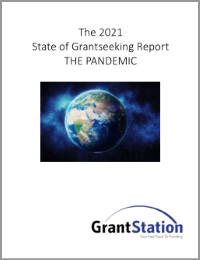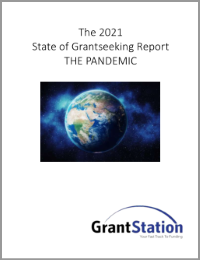
Download a copy of the State of GrantSeeking™ 2021 Pandemic Sub-Report
The Pandemic

A year ago, during The 2020 State of Grantseeking™ Survey, we saw in real time the birth of COVID-19’s impact on grantseeking and nonprofit organizations. One random reference to the pandemic near the end of the survey period morphed into COVID-19 comments in three-quarters of survey responses during the following two weeks.
While many institutional challenges existed long before the pandemic, the stark reality is that other issues faced by grantseekers have been exacerbated by this worldwide health crisis. Yet there have been successes—agile organizations and funders, skillful organizational leadership, and aid provided to those in need.
This year, within The 2021 State of Grantseeking™ Survey, we were able to ask participants how they have fared during the past year, through the lens of the COVID-19 crisis.
Staffing
We asked organizations what, if any, staffing changes they made due to COVID-19. Over half of respondents (51%) told us that they and their staff pivoted to virtual or work from home status. Many organizations were able to retain staff (27%), move staff to other functions or programs (26%), or add staff (20%). Other organizations laid off some (19%) or all (2%) staff.

Sixteen percent of respondents added that they made other staff changes. Those changes included furloughing some or all staff, imposing hiring freezes, and reducing staff hours. We also want to acknowledge and extend our sympathy to those respondents who told us that they lost staff to the COVID-19 virus.
We do not provide an analysis of this year’s survey results as compared to last year’s because there are variations in respondent organizations over time. However, while we draw no conclusions, the change in cost reduction techniques is striking.

Fundraising Events
Nonprofit organizations often rely on in-person fundraising events to provide a portion of their budgets, increase their community profile, and highlight their good works. Due to COVID-19 restrictions, pandemic limitations, and CDC guidelines, many fundraising events were cancelled.
Many respondents replaced lost income via new or additional grantseeking (48%), virtual events (47%), or social media campaigns (44%). Among the “other” replacements were socially distanced events, personalized board outreach, radio advertisements, and online fundraising platforms.

For most respondents (79%), these event replacements raised less (58%) or the same amount (21%) of money; 21% raised more money with the replacement events or activities.

Organization And Program Impact
We asked respondents to tell us about any changes or innovations they made to organizational programs because of COVID-19; 1,815 of our respondents took the time to comment.
Flexibility, technological solutions, the ability to pivot, and meeting the mental and physical health requirements of staff and service recipients were key themes throughout the commentary.
Technology enabled organizations to continue with their missions, programs, fundraising, and communications. The word “virtual” appeared 713 times, while “online” appeared 292 times. “Zoom” was referenced 155 times and “remote” appeared 116 times. Organizations were flexible and pivoted from in-person programs and activities to remote activities. These activities included meetings with clients, support groups, e-clinics for mental and physical well-being, telehealth, school programs, art and music programs, story times, law services, board meetings, conferences, fundraisers, and many, many more examples.
Organizations with programs that depended on in-person contact did so in a socially distanced manner, moved outdoors, or moved (in the case food-security programs) to a home delivery model. Many respondents referenced strict adherence to CDC guidelines.
Respondents mentioned cost savings from virtual programming, and while some organizations will resume in-person services as soon as it is feasible, others are considering hybrid models and still other organizations may not return to in-person programming.
The word “health” appeared 168 times within respondent commentary. The context ranged from telehealth programming to COVID-related counseling to the implementation of health and safety measures.
This two-word response summarized the commentary and reflected the resilience of the nonprofit community: “we adapted”.

Funder Responsiveness
Grantmakers, like nonprofit organizations, often had to change their operations and activities in the face of the pandemic. Our respondents told us that, in general, funders had clearly communicated eligibility and other guidelines for their COVID-19 relief programs (69%). Twelve percent of respondents felt that funders were unclear in their communications and 19% of respondents were unsure about communication clarity.
Our respondents reported that many funders reacted to the pandemic by responding more quickly to grant requests and shortening their grant cycle (37%), while for other funders it was “business as usual”, with no change to the grant cycle or speed (27%). Thirty-six percent of our respondents had a less positive funder interaction; 21% reported slower responses to grant requests and longer grant cycles, while 15% reported that funders either cancelled or indefinitely suspended funding.

Respondents told us that, among funders that had already given an award, there was often immediate responsiveness to the pandemic-fueled changing needs of nonprofit organizations.

These funders often provided more leniency in meeting specific timelines (58%), authorized changes to program objectives (55%), allowed program/project funding to be converted into general operating support (38%), or reached out to determine the financial health of their grantee (26%). Respondents also reported that funders awarded grants early or notified them of additional available funding. However, other respondents told us that their funders cancelled awards or enforced the return of previously awarded monies when the funded programs/projects were delayed or suspended by the pandemic.
CORONAVIRUS-SPECIFIC GRANT FUNDING
Over three-quarters of respondents (76%) applied for coronavirus-specific grant funding opportunities. Of those, 68% received a coronavirus-specific grant award.

Of those organizations that received coronavirus-specific grant awards (excluding coronavirus relief funding administered by the SBA), 27% reported total funding under $25,000. Forty-seven percent reported total coronavirus-specific grant awards of $25,000 or more, and 26% reported that they received no coronavirus-specific grant awards.

Among organizations that received coronavirus-specific grant awards (excluding coronavirus relief funding administered by the SBA), the median of the largest individual award was $25,000.
Many organizations did apply for coronavirus relief funding administered by the SBA, either in the form of the Paycheck Protection Program (PPP), the Economic Injury Disaster Loan (EIDL), or both. Sixty-one percent reported applying for the PPP, while 13% applied for the EIDL, and 37% did not apply for SBA coronavirus relief funding. Of those that applied for SBA coronavirus relief funding, 58% received PPP monies, while 12% received EIDL funding, and 39% received no SBA funding.
The median total dollar amount of SBA coronavirus relief funding reported by survey respondents was $77,750.


Download a copy of the State of GrantSeeking™ 2021 Pandemic Sub-Report